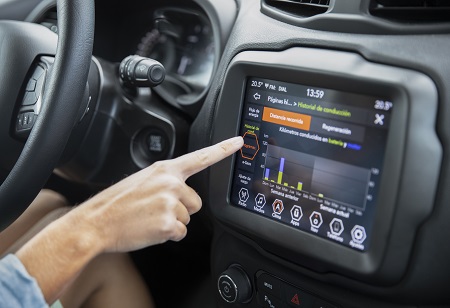How Infotainment Systems are Revolutionizing the Driving Experience
The concept of infotainment systems was first introduced in the 1930s with the in-car radio system, which provided drivers and passengers with entertainment while traveling. The technology progressed from simple radio systems to cassette players and further evolved into CD players, with navigation functionality added later. High-end vehicle capabilities underwent significant transformation during the early 2000s due to the addition of touch screens and GPS systems. Manufacturers started merging entertainment features with navigational and communication abilities with the rise of smartphone and wireless connectivity. Progress in automotive technology established core elements of modern infotainment systems that people use to communicate and navigate while driving.
Today’s automotive industry presents updated digital versions of classic car dashboards. Modern vehicles feature infotainment systems that unite information technologies with entertainment features as standard components in today's automotive landscape. Modern automotive infotainment systems through their navigation features, voice commands, music streaming and smartphone connectivity features are transforming the driving experience.
The Evolution of In-Car Entertainment
Modern automobiles now operate through these central information hubs which moved past their original radio and CD playback roles. Mechanical driving still exists, but digital systems have become more prominent. Infotainment systems for cars have developed from their original AM/FM radio functionality through multiple stages to reach their current multimedia format. Additionally, the automotive infotainment system gained competitive importance after brands like Tesla, BMW and Audi began pushing boundaries that altered consumer purchasing behavior and expectations.
The present market features standard infotainment systems across new vehicles that connect smartphone directly through Apple CarPlay and Android Auto interfaces. The systems provide more than entertainment functions because they provide real-time traffic information as well as weather forecasts and vehicle diagnostic data through one integrated interface.
Enhancing Safety through Integrated Features
A modern infotainment system stands out due to how it improves safety when driving on the road. Drivers who use voice recognition and hands-free operation can navigate, receive phone calls and alter audio tracks by using their voice commands without taking their eyes off the road or hands off the wheel. Advanced infotainment systems in cars utilize AI technology to forecast driver actions while recommending choices like automatic phone calls to frequent contacts or suggest routes based on prior usage.
Several automotive infotainment systems integrate Advanced Driver Assistance Systems (ADAS) which deliver functionality including lane departure warnings and collision alerts along with blind-spot monitoring. The merging of technology for entertainment with automated driver safety functions demonstrates the substantial development of these systems throughout history.
Customization and Flexibility with Aftermarket Options
New vehicle owners benefit from built-in superior infotainment technologies but some people remain unwilling to buy entire new vehicles to experience these advantages. Aftermarket infotainment systems enter the market at this point, to meet the evolving customer demands. Aftermarket systems enable drivers to reach the benefits of modern technology at an affordable rate for older vehicles. The functionality of a vehicle improves dramatically by adding aftermarket solutions which include GPS navigation with large touch screens along with Bluetooth technology and reverse camera capabilities.
The main benefit of using an aftermarket infotainment system lies in its personalized features. Users have multiple options among features that match their individual requirements alongside their particular driving styles. Users enjoy the option to modify their driving experience through these systems because they can fit any budget.
Entertainment Meets Productivity
Automobile infotainment systems currently let drivers stay productive while enjoying entertainment on the go. More and more car infotainment systems have integrated voice assistants like Siri, Google Assistant, and Alexa for user accessibility. People driving vehicle can now organize appointments while using their messaging systems and accessing news updates without looking at their phones. Some automotive infotainment systems provide built-in Wi-Fi which transforms the vehicle into an on-the-go workspace.
Streaming services currently function as standard components in automobile systems. Users of Spotify, Apple Music, YouTube Music and podcasts can customize their listening sessions on platforms that accompany their driving and passenger experiences. Driving becomes more interesting and satisfying through the smooth combination of work and entertainment features.
The Rise of Smart Connectivity
The central characteristic of modern infotainment systems involves smart connection capabilities. The systems link to cloud-based services to receive real-time updates and wireless OTA (over-the-air) software improvements. Users can maintain a current system without manual upgrades or dealership visits.
Infotainment systems hold essential functions in electric and hybrid vehicle operations. Such systems offer comprehensive monitoring of energy usage and charging information along with route planning capabilities that adjust routes according to battery levels. The integration level at this point establishes innovative benchmarks for operational performance together with interface quality.
Future Trends and Innovations
The evolution of automotive infotainment systems becomes even more advanced because of developments in artificial intelligence along with augmented reality capabilities and 5Gconnectivity. Different forms of technology such as HUDs (heads-up displays) for windshield projection and gesture commands and AI-driven services are currently being developed and tested by manufacturers.
Infotainment systems now incorporate V2X (vehicle-to-everything) communication technology as an evolving trend in automotive technology. Cars obtain enhanced safety with V2X communication through their ability to connect with traffic signals and road elements along with other vehicles. In this smart mobility era the infotainment system serves as more than just a feature because it has become the central linking point of an interconnected smart mobility network.
A New Era of Driving
Manufacturers now consider infotainment systems primary features rather than luxury extras for the driving experience. These technologies which come either in factory standard format or aftermarket systems provide more than music and navigation capabilities because they transform driver interactions with both vehicles and their environment. Car infotainment systems showcase continuous development toward creating personalized experiences that combine vehicle connectivity with enjoyable driving journeys for every type of driver.
Moreover, as vehicles become more autonomous and electrified, the automotive infotainment system will play a pivotal role in how users experience time spent in the car. From seamless digital interfaces to predictive personalization, the journey of infotainment is just beginning. It’s not just enhancing the way we drive, it’s transforming the very meaning of mobility in the 21st century.
🍪 Do you like Cookies?
We use cookies to ensure you get the best experience on our website. Read more...






